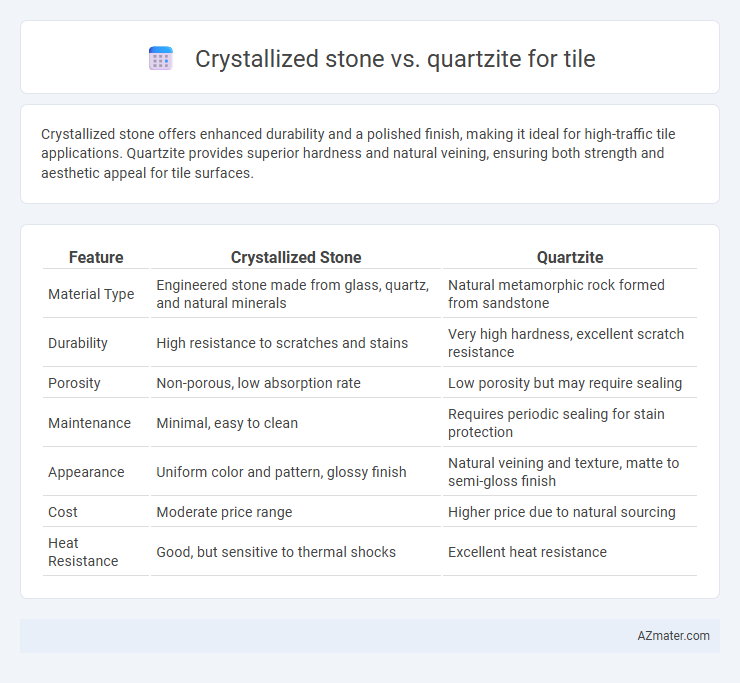Crystallized stone offers enhanced durability and a polished finish, making it ideal for high-traffic tile applications. Quartzite provides superior hardness and natural veining, ensuring both strength and aesthetic appeal for tile surfaces.
Table of Comparison
| Feature | Crystallized Stone | Quartzite |
|---|---|---|
| Material Type | Engineered stone made from glass, quartz, and natural minerals | Natural metamorphic rock formed from sandstone |
| Durability | High resistance to scratches and stains | Very high hardness, excellent scratch resistance |
| Porosity | Non-porous, low absorption rate | Low porosity but may require sealing |
| Maintenance | Minimal, easy to clean | Requires periodic sealing for stain protection |
| Appearance | Uniform color and pattern, glossy finish | Natural veining and texture, matte to semi-gloss finish |
| Cost | Moderate price range | Higher price due to natural sourcing |
| Heat Resistance | Good, but sensitive to thermal shocks | Excellent heat resistance |
Introduction: Crystallized Stone and Quartzite Overview
Crystallized stone is a man-made material composed of natural minerals fused at high temperatures, offering enhanced durability and a consistent appearance ideal for tile applications. Quartzite, a natural metamorphic rock formed from sandstone, boasts exceptional hardness and resistance to heat and scratches, making it highly sought after for flooring and wall tiles. Both materials provide distinct aesthetic and functional qualities that influence tile selection based on project requirements.
Formation and Composition Differences
Crystallized stone forms through a high-temperature, high-pressure process that recrystallizes original sedimentary rock into a denser, harder material with interlocking mineral grains, often including quartz and feldspar. Quartzite is a metamorphic rock primarily composed of nearly pure quartz sand grains fused together by natural recrystallization, resulting in a highly durable and chemically resistant tile surface. The key difference lies in crystallized stone's mixed mineral composition and synthesis, whereas quartzite consists predominantly of quartz, influencing their respective hardness, porosity, and appearance in tile applications.
Appearance and Aesthetic Qualities
Crystallized stone tiles feature a sleek, glass-like finish with a consistent color palette that enhances modern and minimalist interior designs. Quartzite tiles display intricate, natural veining and a more varied texture, providing a luxurious and organic aesthetic ideal for classic and rustic spaces. Both materials offer high durability, but quartzite's natural patterns create a unique visual appeal unmatched by the uniformity of crystallized stone.
Strength and Durability Comparison
Crystallized stone offers exceptional hardness and scratch resistance, making it highly durable for heavy traffic areas, while quartzite is a natural metamorphic rock known for its superior strength and resistance to heat and stains. Quartzite typically scores around 7 on the Mohs hardness scale, providing excellent durability, whereas crystallized stone, often engineered with advanced sintering technology, can match or exceed this hardness with enhanced non-porous properties. Both materials are suitable for tile applications, but crystallized stone often excels in maintenance ease due to its negligible porosity compared to quartzite's natural grain and slight absorbency.
Water Resistance and Porosity
Crystallized stone exhibits lower porosity and higher water resistance compared to quartzite, making it more suitable for wet environments and reducing the risk of staining. Quartzite, being a natural metamorphic rock, has a more porous structure that can absorb moisture unless properly sealed. The enhanced density and non-porous nature of crystallized stone ensure superior durability and minimal water absorption for tile applications.
Maintenance and Cleaning Requirements
Crystallized stone tiles require regular sealing to prevent staining and maintain their polished appearance, while quartzite tiles are naturally more resistant to stains and scratches, demanding less frequent sealing. Cleaning crystallized stone involves using pH-neutral cleaners to avoid damaging the surface, whereas quartzite tiles can be safely cleaned with mild soap and water, ensuring longevity with minimal upkeep. Both materials benefit from prompt spill cleanup, but quartzite's enhanced durability typically makes it easier to maintain in high-traffic areas.
Cost and Affordability Analysis
Crystallized stone tiles generally cost less than quartzite, making them a popular choice for budget-conscious homeowners seeking the appearance of natural stone. Quartzite, being a natural metamorphic rock, commands a higher price due to its durability and unique patterns, which often justify the investment in high-traffic areas. When weighing cost and affordability, crystallized stone offers a more economical option with easier maintenance, while quartzite provides long-term value through enhanced toughness and resistance to wear.
Installation Process and Considerations
Crystallized stone tiles require professional installation due to their hardness and brittleness, often necessitating specialized diamond blade cutters and careful handling to avoid chipping. Quartzite tiles, while also hard and dense, offer slightly more flexibility during installation but still demand precise cutting tools and a skilled installer to prevent cracking. Both materials benefit from a high-quality, polymer-modified thin-set mortar and proper substrate preparation to ensure long-lasting adhesion and durability.
Best Applications for Crystallized Stone vs Quartzite
Crystallized stone offers superior durability and non-porous properties, making it ideal for high-traffic areas, kitchen countertops, and bathroom vanities where stain resistance and easy maintenance are critical. Quartzite excels in outdoor applications, flooring, and wall cladding due to its natural hardness and resistance to heat, scratches, and weathering. Both materials provide excellent aesthetic appeal, but crystallized stone suits modern interiors demanding hygienic surfaces, while quartzite fits rustic or natural design schemes requiring rugged performance.
Conclusion: Choosing the Right Tile for Your Project
Crystallized stone offers exceptional durability and a polished finish ideal for high-traffic areas, while quartzite provides superior natural strength and scratch resistance, making it perfect for both indoor and outdoor applications. Each material's unique properties cater to specific design needs and maintenance preferences, influencing the long-term performance and aesthetic appeal of your project. Selecting between crystallized stone and quartzite depends on balancing factors such as durability requirements, environmental exposure, and desired visual characteristics to ensure the best tile choice for your space.

Infographic: Crystallized stone vs Quartzite for Tile
 azmater.com
azmater.com